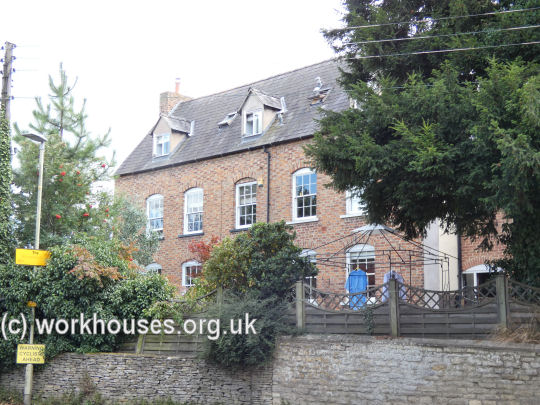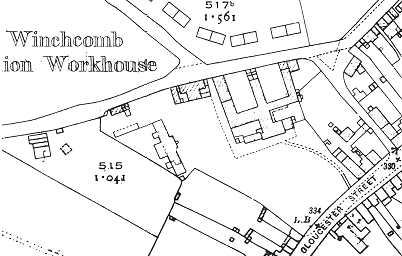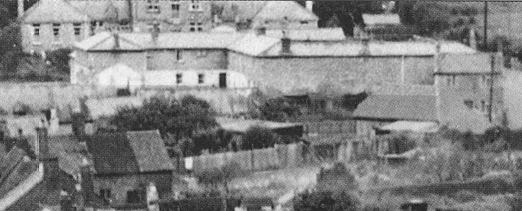Winchcomb, Gloucestershire
Up to 1834
In 1746, the overseers at Winchcomb (now Winchcombe) began renting Abbey House (also known as Water Abbey) at the north side of what is now Abbey Terrace, Winchcombe (SP023283). In 1776, the premises could house seventy inmates. In 1813, the parish relieved forty paupers in the workhouse. The Abbey House was demolished in 1815.
In 1783, the Bishop's Cleeve overseers began making use of the Winchcomb workhouse. In 1801, Bishop's Cleeve and Woodmancote established a joint workhouse on what Station Road, Bishop's Cleeve. Woodmancote opened its own poorhouse in 1808 on Gambles Lane.

Former Bishop's Cleeve Workhouse, 2020.
© Peter Higginbotham.
After 1834
Winchcomb (now usually spelt Winchcombe) Poor Law Union was formed on 16th January 1836. Its operation was overseen by an elected Board of Guardians, 32 in number, representing its 30 constituent parishes as listed below (figures in brackets indicate numbers of Guardians if more than one):
County of Gloucester:
Alderton and Dixon, Grafton (in Beckford), Buckland, Bishop's Cleve [Cleeve], Charlton Abbots, Didbrook, Dumbleton, Gotherington, Temple Guiting, Lower Guiting [Guiting Power], Hailes, Hawling, Pinnock and Hyde, Prescott, Rowell [Roel], Snowshill, Southam and Brockhampton, Stanley Pontlarge, Stanton, Stanway, Sudeley, Toddington, Great Washbourne, Winchcomb (3), Woodmancott [Woodmancote], Wormington.
County of Worcester:
Alstone, Cuttesdean, Little Washbourne.
Later Additions: Alstone.
The population falling within the Union at the 1831 census had been 9,715 with parishes ranging in size from Rowell (population 38) to Winchcomb itself (2,514). The average annual poor-rate expenditure for the period 1833-5 had been £4,911 or 10s.1d. per head.
The new Winchcomb Union workhouse was built in 1836 on a site to the west of the town at the north side of Gloucester Street. The Poor Law Commissioners authorised an expenditure of £3,750 on construction of the building which was intended to accommodate 180 inmates. It was designed by the Sampson Kempthorne who designed many other workhouses including one for the Thornbury Union. His design for Winchcomb was based on his model "200 pauper" plan. An entrance and administrative block lay at the south, with accommodation ranges behind in a cruciform layout. However, there was no central supervisory hub to the building. The workhouse location and layout are shown on the 1921 map below.

Winchcomb workhouse site, 1921.
A later building at the west of the workhouse may have been an infirmary block.

Winchcomb workhouse from the east.
On the morning of 19 October 1920, an unusual noise attracted the attention of one of the workhouse inmates. On investigation, he found the infirmary's night nurse bound and gagged, and near suffocating. Some weeks previously, a letter of an illiterate character, but containing threats, had been found pushed under the infirmary door. The institution's bell had also been rung and the door knocked during the night-time on several occasions. It was supposed that the nurse's unknown assailant had reappeared and managed to gain admittance. Due to the darkness she was unable to give any description.
After 1930, the workhouse was redesignated as a Public Assistance Institution. The buildings have now been demolished.
Staff
Inmates
Records
Note: many repositories impose a closure period of up to 100 years for records identifying individuals. Before travelling a long distance, always check that the records you want to consult will be available.
- Gloucestershire Archives, Clarence Row, Alvin Street, Gloucester GL1 3DW. Holdings include: Guardians' minute books (1836-1935); Admissions and discharges (1836-44); Master's journal (1848-1934).
Bibliography
- Higginbotham, Peter The Workhouse Encyclopedia (2014, The History Press)
Links
- None.
Unless otherwise indicated, this page () is copyright Peter Higginbotham. Contents may not be reproduced without permission.


